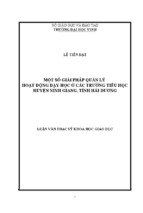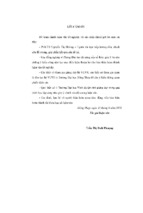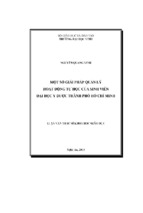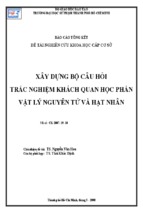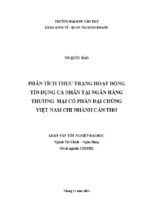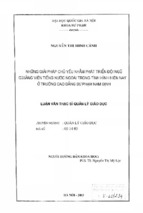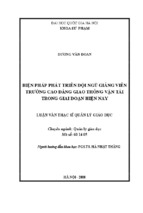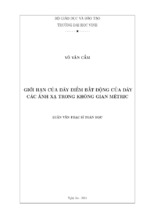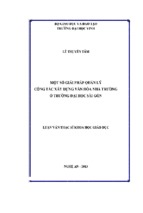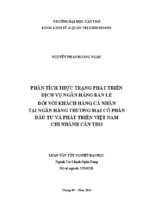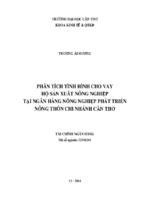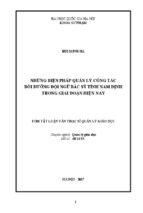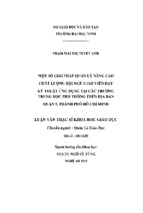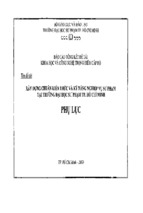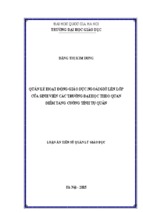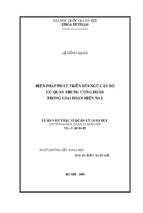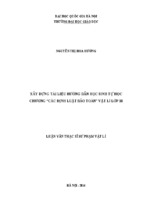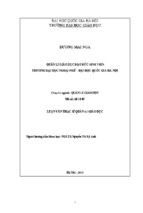VIETNAM NATIONAL UNIVERSITY, HANOI
UNIVERSITY OF LANGUAGES AND INTERNATIONAL STUDIES
FACULTY OF POST - GRADUATE STUDIES
*********************
TRẦN THỊ HÒA
TEACHERS’ AND STUDENTS’ ATTITUDES TOWARDS
CODE-SWITCHING IN EFL CLASSROOMS AT RURAL
HIGH SCHOOLS
( Quan điểm của giáo viên và học sinh với việc sử dụng tiếng Việt trong
các lớp học tiếng Anh tại các trường cấp 3 nông thôn)
M.A. MINOR PROGRAMME THESIS
HANOI-2019
VIETNAM NATIONAL UNIVERSITY, HANOI
UNIVERSITY OF LANGUAGES AND INTERNATIONAL STUDIES
FACULTY OF POST - GRADUATE STUDIES
*********************
TRẦN THỊ HÒA
TEACHERS’ AND STUDENTS’ ATTITUDES TOWARDS
CODE-SWITCHING IN EFL CLASSROOMS AT RURAL
HIGH SCHOOLS
( Quan điểm của giáo viên và học sinh với việc sử dụng tiếng Việt trong
các lớp học tiếng Anh tại các trường cấp 3 nông thôn)
M.A. MINOR PROGRAMME THESIS
Field: English Teaching Methodology
Code: 8140231.01
Supervisor: Assoc. Dr. Lê Văn Canh, PhD
HANOI-2019
ACKNOWLEDGEMENTS
This thesis could not have been completed without the help and support
from a number of people.
First and foremost, I would like to express my sincere thanks to my
lecturer and my supervisor, Assoc. Dr Le Van Canh, PhD, who has patiently
and constantly supported me through the stages of the study, and whose great
ideas, expertises and suggestions have helped me a lot to handle the task.
A special word of thanks to my colleagues and my students in rural high
schools in Thanh Hoa province for their effective cooperation in collecting
data for completing this research.
Last by not least, I am greatly indebted to my family for the sacrifice I
received to finish this academic work.
i
DECLARATION
I declare that this thesis is the result of my own work submitted for the
Master of Art degree in English Teaching Methodology at Faculty of Post Graduate Studies, Hanoi University of Languages and International Studies,
Vietnam National University, and has not been previously submitted to any
other universities for any degrees. This work was finished with the
contributions of other researchers which were indicated clearly with the
references. The study was done under the guidance of Associated Professor
Le Van Canh at Hanoi University of Languages and International Studies.
Approved by SUPERVISOR
(Signature and fullname)
Lê Văn Canh
Date:……………………
Hanoi, 2019
Trần Thị Hòa
ii
ABSTRACT
The use of mother tongue or code-switching in the EFL (English as a
foreign language) classrooms has created controversy for many years and its
role in the different teaching methods that have been developed has also been
clearly defined. Conducted in the context of a Vietnamese rural area, the
study is to examine the teachers’ and students’ attitudes toward codeswitching use in English classrooms, find out if there are differences between
students’ and teachers’ attitudes and identify how often teachers codeswitch
in EFL classrooms. This research was conducted at two rural high schools in
Thanh Hoa province, one of them where I was working and 50 students and 6
teachers participated in the study. Data was collected by means of recorded
lesson observations, interviews and questionnaires. In general, the results of
this study showed that both teachers and students were positive towards the
use of mother tongue (Vietnamese) in English classrooms but only under
certain circumstances. The use of code-switching means using both English
and Vietnamese in EFL classrooms does not seem to hinder their English
learning process, but having to speak only English does make students have
negative feelings because they are students in a rural area, their ability and
learning condition are limited.
iii
LIST OF ABBREVIATIONS
ALM: Audio-Lingual Method
CLT: Communicative Language Teaching
EFL: English as a foreign Language
FL: Foreign language
GMT: Grammar Translation Method
L1: First language
L2: Second language
TL: Target language
iv
TABLE OF CONTENTS
ACKNOWLEDGEMENTS.............................................................................i
DECLARATION.............................................................................................ii
ABSTRACT....................................................................................................iii
LIST OF ABBREVIATIONS........................................................................iv
TABLE OF CONTENT..................................................................................v
LIST OF FIGURES AND TABLES............................................................vii
PART A: INTRODUCTION..........................................................................1
1. Rationale........................................................................................................1
2. Aims and Objectives of the Research...........................................................2
3. Research Questions.......................................................................................2
4. Scope of the Study.........................................................................................3
5. Significance of the Study..............................................................................3
6. Structural Organization of the Thesis............................................................4
PART B: DEVELOPMENT...........................................................................6
CHAPTER 1: LITERATURE REVIEW......................................................6
1.1. Definition of Code-switching.....................................................................6
1.2. History of language teaching methods focusing on code-switching in EFL
classroom...........................................................................................................6
1.3. Arguments about the use of code-switching or L1 in EFL classrooms......8
1.3.1. Arguments against using code-switching or L1 in EFL classrooms.......8
1.3.2. Arguments in favour of code-switching in EFL classrooms.................10
1.4. Studies focusing on teachers’ code-switching in EFL classrooms...........12
1.4.1. The attitudes of teachers and students...................................................12
1.4.2. Amount of code-switching use..............................................................15
1.4.3. Situations of code-switching use...........................................................15
v
CHAPTER 2: METHODOLOGY...............................................................17
2.1. Research Methodology.............................................................................17
2.2. Setting and participants............................................................................17
2.3. Data collection instruments and procedure..............................................17
2.3.1. Classroom Observation.........................................................................17
2.3.2. Questionnaires.......................................................................................18
2.3.3. Interview................................................................................................18
2.4. Data analysis procedure............................................................................19
CHAPTER 3: DATA ANALYSIS AND DISCUSSION............................20
3.1. Data analysis............................................................................................20
3.1.1. Classroom observation analysis............................................................20
3.1.2. Analysis of teachers’ interviews results................................................25
3.1.3. Analysis of students’ questionnaire results...........................................29
3.2. Discussion................................................................................................34
3.2.1. How often do teachers codeswitch on average in the lesson?...............34
3.2.2. What are the attitudes of the teachers towards code-switching?...........35
3.2.3. What are the attitudes of the students towards code-switching?...........35
3.2.4. Are there any differences between students’ and teachers’ attitudes
towards code-switching?.................................................................................36
PART C: CONCLUSION.............................................................................38
REFERENCES..............................................................................................42
APPENDICES..................................................................................................I
Appendix 1.........................................................................................................I
Appendix 2......................................................................................................XI
Appendix 3.....................................................................................................XII
vi
LIST OF FIGURES AND TABLE
Table 3.1: Situations of teachers’ code-switching in EFL classrooms............22
Table 3.2: The results of students’ multiple choice questions........................29
Table 3.3: Suitable amount of English.........................................................32Y
Figure 3.1: The amount of code-switching use in observed classes...............20
vii
PART A: INTRODUCTION
1. Rationale
There has been a growing interest in learning English as a second/foreign
language over the last few decades. This is due to the important role English
plays in almost every aspect of life nowadays, starting from education to
business (Hasman 2004). In addition, English has become a global lingua
franca and a mean of international communication round the world (BruttGriffle, 1998). It has allowed people from different cultures and linguistic
backgrounds to communicate and share their knowledge and expertise.
Moreover, English has become “a key part of the educational strategy in most
countries” (Graddol, 2006 p.70). This explains why governments have
exerted to introduce English language as early as possible to their educational
systems, in an attempt to help their citizens to be effective users of the target
language in the future.
In the process of teaching and learning foreign language, using mother
tongue or foreign language only in the classroom remains virtually
unquestioned. This has been still controversy topic for many ages, especially
Communicative Language Teaching become more popular. In global scale,
many studies were conducted to investigate the code-switching technique or
the use of mother tongue in EFL (English as a foreign language) classrooms
with the different results. Ellis (1984), Wong-Fillmore (1985), Chaudron
(1988), Lightbown (2001), believe that teachers should aim at creating a pure
foreign language environment since they are the sole linguistic models for the
students and that code-switching will result in negative transfer in FL
learning. On the contrary, researchers in support of crosslingual (codeswitching) teaching strategy including Tikunoff and Vazquez-Faria (1982),
1
Levine (2003), Chen Liping (2004), etc., argue that the first language can
promote the learning of target language and the first language deserves a
place in foreign language classroom. And code-switching is a good strategy
of efficiency in foreign language classrooms. In Vietnam, some researchers
also investigated the attitudes of teachers and students towards the codeswitching in EFL classrooms at Universities, English center and High
schools. However, it is very difficult to find out a study which is conducted in
a rural area where students’ levels are very low and the teachers’ and learners’
beliefs about learning English are different from people in urban
environments. That is reason why the researcher conducted this study in this
context.
2. Aims and Objectives of the Research
This research project aims to explore teachers’ and students’ opinions
regarding code-switching use in English classrooms in the context of rural
High schools. To achieve the above aims, the following objectives are set for
exploration:
-
Examining the teachers’ and students’ attitudes towards code-switching use
in English classrooms at 2 rural High schools.
- Identifying if there are the differences between students’ and teachers’
attitudes towards code-switching in EFL classrooms.
- Identifying how often teachers codeswitch in their lessons.
3.Research Questions
The aim of this investigation is to explore the attitudes of rural teachers
and students towards the use of code-switching in EFL classrooms. The
current study aims to answer the following research questions:
-
How often do teachers codeswitch on average in the lesson?
-
What are the attitudes of the teachers towards code-switching?
2
-
What are the attitudes of the students towards code-switching?
Are there any differences between students’ and teachers’ attitudes
towards code-switching?
4. Scope of the Study
Within the framework of this minor thesis, the study focused on both
students’ and teachers’ attitudes (the teachers of English) towards the codeswitching in English classrooms at High schools in rural area. The data for
analysis is taken from teachers’ interviews and observations and students’
questionnaires at some High schools. The participants are 6 teachers of
English and one hundred students at these High schools in Thanh Hoa
province.
5. Significance of the Study
Educational policy-makers in a lot of countries seem to have adopted the
monolingual approach. Although there are a lot of researches that support the
inclusion of learners’ mother tongue (Schweers, 1999; Swain & Lapkin,
2000; Burden, 2001; Prodromou 2002; Tang 2002; Al-Nofaie, 2010), such
pedagogical decisions regarding the exclusion of learners’ the first language
have been made on “unexamined and taken-for-granted assumptions
(Auerbach, 1993, p.29). Moreover, there does not seem to be enough evidence
that both teachers’ and students’ input has been taken into consideration.
Since teachers and students are the most important key players in the
education, a lot of studies have been carried out to investigate their
perceptions towards the use of learners’ mother tongue in learning another
language. This study focused on investigating the students’ and teachers’
attitudes towards code-switching in EFL classrooms at rural High schools. In
rural area, most of students were not taught listening and speaking skills
carefully at secondary schools, especially listening lessons are often ignored.
3
The rural classrooms always have 40-45 students with different levels of
English. Thus, as a mentioned above, this research is to examine the teachers’
and students’ attitudes towards the use of code-switching in English
classrooms in order to find out if its use gives learners benefits and reduces
the anxiety in learning process and how to use code-switching effectively.
Every teacher of English can use the results of this study as a reference to
consider some change if needed in teacher training process.
6. Structural Organization of the Thesis
The study consists of three main parts, namely Introduction, Development
and Conclusion:
Part A: Introduction
This part provides the rationale, the aims, the scopes, the objectives, the
method and the design of the study
Part B: Development
This part consists of Literature Review, Methodology, Data analysis and
Discussion
- Chapter 1: Literature Review
This chapter provides an overview of definition and history of code-switching
technique in EFL classrooms, some arguments for and against mother tongue
use as well as the reviews of related works in this topic.
- Chapter 2: Methodology
It presents the subject of study, research instruments, collecting data
procedure and data analysis procedure from which answers for the research
questions.
- Chapter 3: Findings and Discussion
The data collection from observations, interviews and questionnaires are
analyzed in this chapter so the findings and discussion will be presented
4
Part C: Conclusion
This part has the major findings, some recommendation, limitation of the
research as well as the suggestions for the further study
The references and appendices are the last parts of the study.
5
PART B: DEVELOPMENT
CHAPTER 1: LITERATURE REVIEW
1.1.Definition of Code-switching
The concept of code was put forward by Bernstein (1971). It refers to any
system of signals, such as numbers, words, which carries concrete meaning.
Wardhaugh pointed out that the term code is neutral term rather than terms
such as dialect, language, style, pidgin and creole which are inclined to
arouse emotions. Code can be used to refer to “any kind of system that two or
more people employ for communication” (p.86).
In the studies of code-switching, there have been various definitions of
the term “code-switching”. Gumperz referred to it as “the juxtaposition within
the same speech exchange of passages of speech belonging to two different
grammatical systems or subsystems” (Gumperz, 1982, p.59).
Cook (2000, p.83) defines code-switching as the process of “going from
one language varieties within a single conversation or utterance”.
In the context of foreign language classroom, Liu Jingxia (2010) views
code-switching as the alternate use of the first language and the target
language, a mean of communication by language teachers when the need
arises. As this study was conducted in the context where English was taught
and studied as a foreign language, Jingxia’s above definition of codeswitching is adopted.
1.2. History of language teaching methods focusing on code-switching in
EFL classroom
In the history of foreign language (FL) teaching, different linguistics
suggested various methods and approaches which were used for different
periods. The role of the first language in language teaching is one of the most
6
long-standing controversies in the history of language pedagogy (Stern,
1992).
The following glimpse in the historical sequence of the most-
recognized language teaching methods will highlight periodic changes in the
role of L1 in foreign language teaching.
In the early years of the nineteenth century in Western country, the
Grammar Translation Method (GTM) was the standard way of FL teaching.
Foreign language was taught through grammar illustration, bilingual
vocabulary lists and translation exercises. At this time, it was believed that to
learn a language was to read its literature. In GTM classrooms, the students’
native language is the “ medium of instruction”, which is used to explain new
item and to make comparisons between L1 and L2 (Richards & Rodgers,
2001). In other words, FL teachers mostly codeswitch in their GTM
classrooms.
However, some other linguistics strongly criticized the Grammar
Translation Method. In the late nineteenth century, the Western world
experienced a big change in the need of learning languages with the aim of
communicating. This led to the emergence of the Direct Method, which pays
its whole attention to the spoken language. The Direct Method is based on the
belief that FL learning should be an imitation of L1 learning. In this light,
learners should be immersed in the target language (TL) through the use of
that TL “as a mean of instruction and communication in the language
classroom”, and through “the avoidance of the use of L1 and translation as a
technique” (Stern, 1983). After its highest popularity during the period from
the late nineteenth century to the first quarter of the twentieth century, the
Direct Method began to decline. However, the method has laid foundation
upon which many of the later methods and approaches expanded and
developed. Among them are the Audio-lingual Method and Communicative
Approach.
7
Audio-lingual Method (ALM), which was suggested by American
linguistics in 1950s, aims to develop communicative competence of students
by the repetition of dialogues and drills. Supporting this method, LarsenFreeman (2000 cited in Vu Thi Thu Trang, 2016) says the more often
something is repeated, the stronger the habit and the greater the learning. In
ALM classroom, the use of the first language is forbidden because
understanding context as well as grammatical explanation are not necessary.
Communicative Language Teaching (CLT) has the same communicative
purpose to ALM, the CLT has served as a major source of influence on language
teaching practise around the world since its inception in the 1970s (Richards,
2006). The author also suggests a lot of classroom activities that best facilitate
learning such as group work, pair work, role play in CLT classroom.The
Communicative Approach, which has attracted most attention from the language
teaching profession during the fast five decades, the restricted use of learners’
mother tongue is allowed where feasible and translation may be used when
learners find it essential and helpful (Ellis, 2003).
In the twentieth century, there were some popular teaching methods,
which tried to avoid using code-switching or the student’s L1 to develop
communicative language teaching in EFL classroom. However, codeswitching in classroom is still issue which raises many debates among
linguistics, foreign language teachers and learners in the world.
1.3.Arguments about the use of code-switching or L1 in EFL classrooms
1.3.1. Arguments against using code-switching or L1 in EFL classrooms
Since 1980, code-switching as a specific technique in foreign language
got much attention. Some scholars hold a positive attitude for using this
technique in EFL classrooms, whereas some have negative attitude for using
code-switching in EFL classrooms. Scholars such as Ellis (1984), Wong-
8
Fillmore (1985), Chaudron (1988), Light (2001) (cited in Liu Jingxia, 2010)
advocate that teachers should create a pure linguistics environment in EFL
classrooms and code-switching to L1 by EFL teachers will have a negative
impact on target or foreign language learning.
According to Cook (2001), arguments against teachers using students’
mother tongue in the literature are generally organized into three following
reasons:
1. The learning of L2 should model the learning of an L1 (through maximum
exposure to the L2).
2. Successful learning involves the separation and distinction of L1 and L2.
3. Students should be shown the importance of the L2 through its continual use.
(Cook, 2001, p412)
The first reason is based on the rationale from childhood, children
listen, imitate and respond to what they hear around them and then they
succeed in mastering their mother tongue. Therefore, many linguistics suggest
that language learners should be in the surrounding sound environment to get
the best result. According to Krashen and Terrell (1983), as cited in Salah &
Farrah (2012), indicate that L1 use should be excluded in the English
classroom to increase students’ exposure to the target language. Phillipson
(1992, cited in Salah & Farrah, 2012) who has same view, argue that the more
learners exposure to the target language, the more quickly will they learn.
Turnbull (2001) also mentions that students do not benefit if teachers rely too
much on using their students’ mother tongue.
Regarding to Cook’s second principle, the supporters of the
Monolingual Approach have stated that translating between L1 and L2 can be
dangerous as it encourages the belief that there are equivalents between the
language, which is not always the case (Pracek, 2003). They believe that
9
successful FL acquisition depends on keeping L2 separate from L1. One main
reason for thinking this way is the fear of L1 interference (Cook, 2001).
Karshen (1981) in his influential “Second Language Acquisition and Second
Language Learning” also suggests that L1 is a source of errors in learners’
foreign language performance.The proponents of target language exclusivity
argue that it is not necessary for learners to understand everything that is said
to them by the teacher and that switching to the first language undermines the
process of learning (F. Chambers, 1991; Halliwell & Jones, 1991; Macdonald,
1993). For them, teaching entirely through the TL makes the language real,
allows learners to experience unpredictability, and develops the learners’ own
in-built language system (cited in Liu Jingxia, 2010).
Regarding Cook’s third point, Pachler & Field mention that the use of
L2 only in the classroom does help demonstrate the L2’ importance and can
portray the usage of the language being studied (2001, p.86). According to
Sharma (2006), the rationale for using only English in EFL classroom is that
the more students are exposed to English, the faster they learn. Many
monolingual approaches agree with this view, they think that the best way to
learn language is if learners are forced to use it.
1.3.2.Arguments in favour of code-switching in EFL classrooms
The proponents of the bilingual approach have focused their efforts o
three points to discredit the monolingual approach. According to Philipson
(1992, p.191), the biggest problem of the monolingual approach is that “it is
impractical”. There is the fact that non-native speakers account for the vast
majority of teachers of English across the world (Hawks, 2001), cited in
Miles, 2004, p.9). These English teachers are usually not good enough to
carry out the English-only teaching in the classroom; thus, the insistence on
the monolingual approach may result in their reduced ability to communicate
10
and consequently their reduced teaching performance (Miles, 2004, p.9).
Another reason for the monolingual approach’s impracticality is that the
exclusion of L1 in lower-level monolingual classes is practically impossible
(Nunan & Lamb, 1996). As a result, the English-only teaching in the
classroom may create “the alienation of learners from the learning process”
(Pachler & Field, 2001).
More and more researchers, such as Stern (1992) and Cook (2000,
2001) argued that students’ L1 deserves a place in FL classrooms. They
attempted to question the long-held belief of excluding the L1 from the
classroom. Cook (2000) believed that to let students use their mother tongue
is a humanistic approach, as it permits them to say what they really want to
say. The use of students’ L1 is a “learner- preferred strategy” (p.242). Stern
(1992) suggested that it may be the time to “reconsider” the use of
crosslingual strategy, though in theory language teaching today is entirely
intralingual. The learner inevitably works from an L1 reference base, so it can
be helpful for him to “orient himself in the L2 through the L1 medium or by
relating L2 phenomena to their equivalents in L1” (Stern, 1992, p.285).
Moreover, Stern quoted several students’ far less positive opinions on the
exclusive use of the TL.
Atkinson (1987, p.42) also stated that the mother tongue use in the
form of translation technique is a preferred learning strategy for most learners.
This idea has been voiced earlier by Danchev (1982, cited by Christine
Manara, 2007) who states that “translation is a natural phenomenon and an
inevitable part of second language acquisition even where no formal
classroom learning occurs”.
L1 use also reduces the affective barriers to L2 acquisition. According
to D’Annulizios (1991), Garcia (1991), Hemmindinger (1987), Shamash
11
- Xem thêm -

